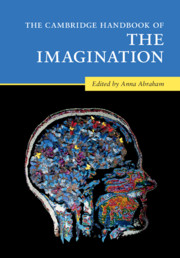Book contents
- The Cambridge Handbook of the Imagination
- The Cambridge Handbook of the Imagination
- Copyright page
- Dedication
- Contents
- Figures
- Contributors
- Acknowledgments
- 1 Surveying the Imagination Landscape
- Part I Theoretical Perspectives on the Imagination
- Part II Imagery-Based Forms of the Imagination
- Part III Intentionality-Based Forms of the Imagination
- Part IV Novel Combinatorial Forms of the Imagination
- Part V Phenomenology-Based Forms of the Imagination
- 34 Imagination in the Philosophy of Art
- 35 Imagination in Aesthetic Experience
- 36 The Arts and Human Symbolic Cognition: Art is for Social Communication
- 37 Aesthetic Engagement: Lessons from Art History, Neuroscience, and Society
- 38 Dance and the Imagination: Be a Butterfly!
- 39 Imagination, Intersubjectivity, and a Musical Therapeutic Process: A Personal Narrative
- Part VI Altered States of the Imagination
- Name Index
- Subject Index
- References
34 - Imagination in the Philosophy of Art
from Part V - Phenomenology-Based Forms of the Imagination
Published online by Cambridge University Press: 26 May 2020
- The Cambridge Handbook of the Imagination
- The Cambridge Handbook of the Imagination
- Copyright page
- Dedication
- Contents
- Figures
- Contributors
- Acknowledgments
- 1 Surveying the Imagination Landscape
- Part I Theoretical Perspectives on the Imagination
- Part II Imagery-Based Forms of the Imagination
- Part III Intentionality-Based Forms of the Imagination
- Part IV Novel Combinatorial Forms of the Imagination
- Part V Phenomenology-Based Forms of the Imagination
- 34 Imagination in the Philosophy of Art
- 35 Imagination in Aesthetic Experience
- 36 The Arts and Human Symbolic Cognition: Art is for Social Communication
- 37 Aesthetic Engagement: Lessons from Art History, Neuroscience, and Society
- 38 Dance and the Imagination: Be a Butterfly!
- 39 Imagination, Intersubjectivity, and a Musical Therapeutic Process: A Personal Narrative
- Part VI Altered States of the Imagination
- Name Index
- Subject Index
- References
Summary
What is it for something to be an artwork, or a particular kind of artwork? What is the nature of the creative processes whereby artworks come into existence? What kinds of cognitive capacities and processes enter into the reception and appreciation of artworks? Philosophers of art have appealed to the imagination in answering each of these questions. I first consider the nature and role of the imagination in traditional conceptions of artistic creation, and why such conceptions are now viewed as more problematic. I then outline Kendall Walton’s highly influential analysis of the nature and appreciation of artistic representations in terms of a kind of imagining that he terms “make-believe.” I also consider Gregory Currie’s analysis of the nature of literary and cinematic fictions in terms of prescriptions to imagine various things, and of the role of the imagination in our engagement with such fictions. I next address recent critical responses to the roles ascribed to the imagination by Walton and Currie. Finally I look briefly at what has been termed the puzzle of “imaginative resistance,” our reluctance to engage in some of the imaginings prescribed by literary and cinematic fictions.
Keywords
- Type
- Chapter
- Information
- The Cambridge Handbook of the Imagination , pp. 565 - 577Publisher: Cambridge University PressPrint publication year: 2020



